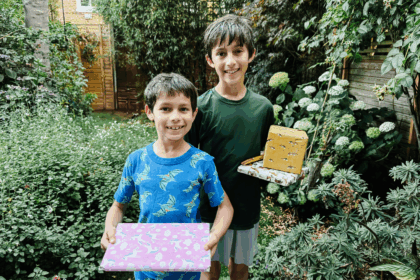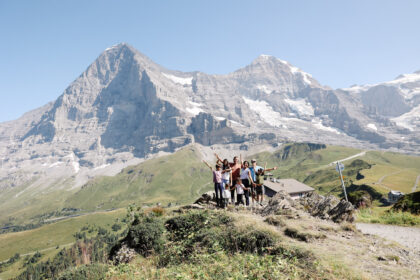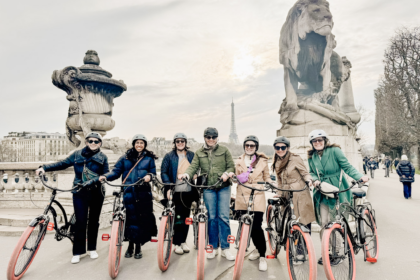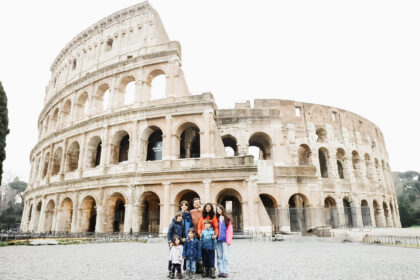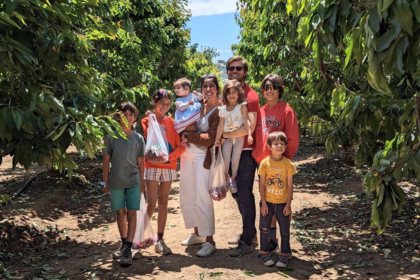One of the most visited U.S. national parks, Yellowstone National Park is also the world’s first national park! Yellowstone National Park is home to an incredible variety of wildlife, including iconic species such as bison, elk, grizzly bears, and wolves. The park’s geothermal features are equally remarkable, including the famous Old Faithful and colorful Grand Prismatic Spring. And it’s an incredible park to visit with kids! We had an absolutely wonderful time as a family and loved finding the best things to do in Yellowstone National Park.
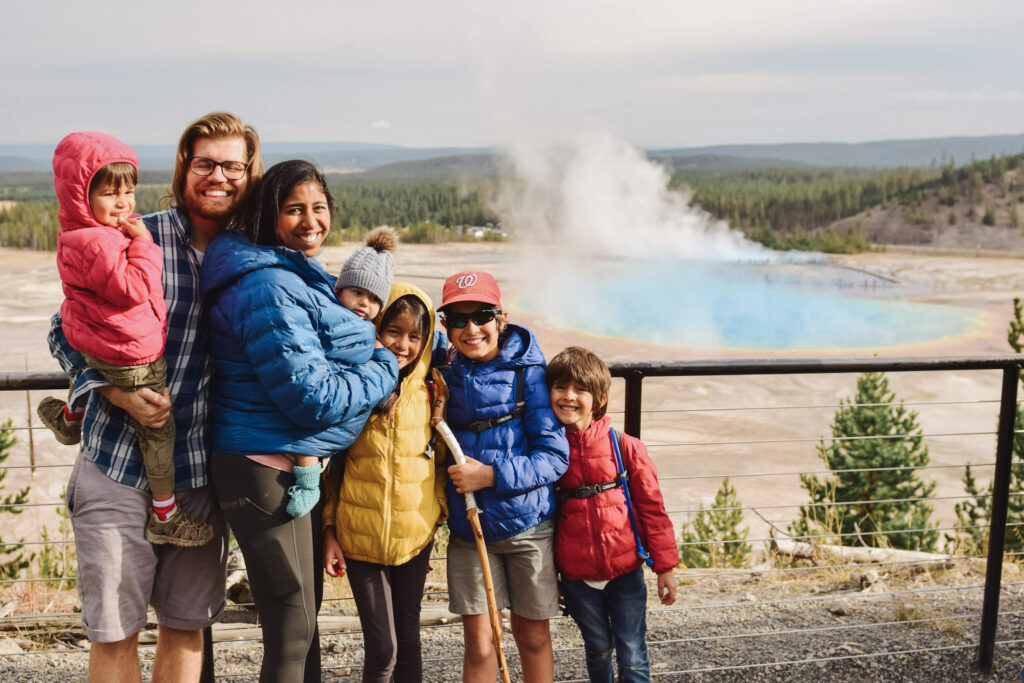
Learn About Yellowstone National Park
Before we visit a national park, our family loves learning about it! It helps us enjoy it more and appreciate the people who have stewarded it well before us. We love learning about the Indigenous history, as well as about wildlife and ecosystems.
Here are a few things to learn about Yellowstone National Park before visiting!
Yellowstone National Park History & Natural Features
- People have been present in the Yellowstone region for more than 11,000 years. Many tribes and bands used the park as their home, hunting grounds, and transportation routes prior to and after European American arrival.
- European Americans began exploring in the early 1800s. John Colter was the first known European-American to visit present-day Yellowstone.
- A series of expeditions to explore the Yellowstone area took place in 1869-1871. The history of science in Yellowstone formally began with Hayden’s expeditions. Hayden’s 1871 survey team included two botanists, a meteorologist, a zoologist, an ornithologist, a mineralogist, a topographer, and an agricultural statistician/entomologist, in addition to an artist, a photographer, and support staff.
- Yellowstone was established as the world’s first national park in 1872.
- After the park was established, it faced a series of conservation threats, including poachers. In 1886, the US Army took charge of Yellowstone to strengthen and enforce park regulations.
- Much of the park closed during World War II due to lack of resources. Visitation jumped as soon as the war ended. By 1948, park visitation reached one million people per year.
- At more than 3,400 square miles,Yellowstone National Park forms the core of the Greater Yellowstone Ecosystem—one of the largest nearly intact temperate-zone ecosystems on Earth.
- Yellowstone is home to the largest concentration of mammals in the lower 48 states, including one of the largest elk herds in North America and one of few grizzly populations in contiguous United States.
- Yellowstone is the only place in the United States where bison have lived continuously since prehistoric times. It is the largest free-roaming, wild herd of bison in United States.
- Yellowstone National Park is one of the most geologically dynamic areas on Earth due to a shallow source of magma and resulting volcanic activity. The park has more than 10,000 hydrothermal features, including approximately 500 geysers—the largest concentration of active geysers in the world—more than half of the world’s total.
- (Source) (Source) (Source) (Source) (Source) (Source)
Yellowstone Indigenous History
- 27 tribes have ties to the area and resources now found within Yellowstone National Park.
- The Tukudika, or Sheep Eaters, are a band of Mountain Shoshone that lived for thousands of years in the area that would become Yellowstone National Park.
- Traditionally, Shoshone names were derived from places the bands traveled to or from foods they hunted or gathered. Tukudika (also Tukudyka’a, Tukadika) means “eaters of the mountain sheep.”
- Traveling in extended-family groups, the Tukudika followed the park’s rivers and streams to hunt game, harvest plants, and find suitable campsites.
- The Tukudika were skilled hunters and artisans known for their horn bows, obsidian arrows and tools, stone-and-timber game and fish traps, sheepskin clothing, and steatite bowls.
- While bighorn sheep was their primary source of meat, the Tukudika’s diet consisted of at least 50% plants, roots, nuts, and berries.
- The Tukudika built simple yet versatile shelters composed of curved lodgepole and grass thatching.
- The Tukudika remained in the park until the late nineteenth century when they were forcibly removed to reservations.
- Although the Tukudika continued to live traditionally for a generation or two after their removal to reservations, they eventually adapted to the ways of these other tribes. By 1900, the Tukudika were incorporated into the Eastern Shoshone tribe of the Wind River Reservation in central-western Wyoming, and into the Mountain and Lemhi Shoshone and Bannock tribes of the Fort Hall Reservation in southeastern Idaho.
- Today, some Tukudika descendants live on the aforementioned reservations. Some of these descendants prefer the name Mountain People to Tukudika or Sheep Eater for its emphasis upon place rather than food source.
- Representatives of Yellowstone’s associated tribes participate in consultation meetings with park managers. They bring tribal perspectives to current issues such as bison management. Tribes also comment on park projects that could affect their ethnographic resources.
- (Source) (Source)
Featured Yellowstone Picture Book: Volcano Dreams: A Story of Yellowstone

Yellowstone Packing List: What to Pack For a Yellowstone Family Vacation
Yellowstone National Park Packing List
- Carry-all backpack – this is our favorite grown-up pack to carry essentials for a day hike
- Kids’ Hiking Backpack – our kids absolutely love these 18L hiking backpacks. They’re perfect as a day pack or for travel – they hold a ton, are sturdy, comfortable, and have a spot for a water bladder. They even work really well on my short torso and I alternate between one of those or this women’s day pack. We also love this 12L kids day hike backpack for younger kids.
- Backpacking Backpack – if you’ll be doing any overnight adventures, we really love this 40L pack for overnights.
- Layers
- Wool base layers + Socks – great for regulating temperature and moisture wicking. Excellent for cold weather, too. Here are all our favorite wool base layers & socks for the whole family.
- Sun protective gear – long shirts or hooded sun shirts work well.
- Rain gear
- I love the bright colors of these REI Co-op rain jackets, as well as how packable they are: Women’s rain jacket, Men’s rain jacket, Kids’ rain jacket, Toddler rain jacket, Baby one piece rain suit
- These REI Co-op rain pants are also really excellent. Waterproof and take up almost no room/weight when packing. Great to wear for wind protection or to stay dry in the snow with layers under, too – especially if you’re traveling but won’t be actively outside for super long periods: Women’s rain pants, Men’s rain pants, Kids rain pants, Toddler rain pants
- If you want something really waterproof and protective, I have and love this women’s rain jacket.
- Sturdy shoes
- These are our favorite hiking boots for women and men, and these hiking sandals for women and men.
- I’d recommend either sneakers with good tread or hiking shoes when exploring Glacier trails with kids. My kids love either hiking sandals, hiking boots, or regular sneakers depending on the type of hike. (I personally prefer my kids to wear kids hiking boots because they’re comfy & waterproof for longer hikes, or the best hiking sandals if we’ll be in water. All our favorites are also available HERE.)
- First aid kit and my favorite bandages (here are all the first aid items we pack when traveling)
- Sunscreen
- I love this kind for kids – it’s mineral-based, provides great protection, great for sensitive skin, and rubs in easily. This is my favorite facial sunscreen for myself (use code LPF15 for 15% off).
- Insect Repellent
- It can definitely get buggy around here, especially in the summer. We love this deet-free repellent (use code LPF15) and this Picaridin-based bug repellent in areas that don’t have a high prevalence of disease-carrying mosquitos (we use Deet in Zika/dengue/malarial areas).
- Quick-Dry Towel
- We like to have one of these quick-dry towels on hand in case of rain or any spills. I also really love these ribbed quick dry towels!
- Hat
- This is my favorite hiking hat and my favorite hat for babies.
- Camera equipment
- Water/snacks
- We love this water bottle and this water bottle for adults.
- This hydration backpack for kids is a favorite. (Also available here.)
- My older kids LOVE this water bottle.
- This and this are our favorite water bottles for toddlers.
- Child hiking carrier – Yellowstone National Park has a number of wonderful hikes, and we love having a carrier to pack along a baby or toddler when visiting Yellowstone with kids. This is our favorite backpack hiking carrier for visiting Yellowstone National Park with toddler that also has plenty of room for snacks and even our big camera. We also love this soft structured carrier for younger babies, and this one is excellent for travel, especially if you won’t be using it all the time (it packs up small) or will be getting wet (it dries in a flash).
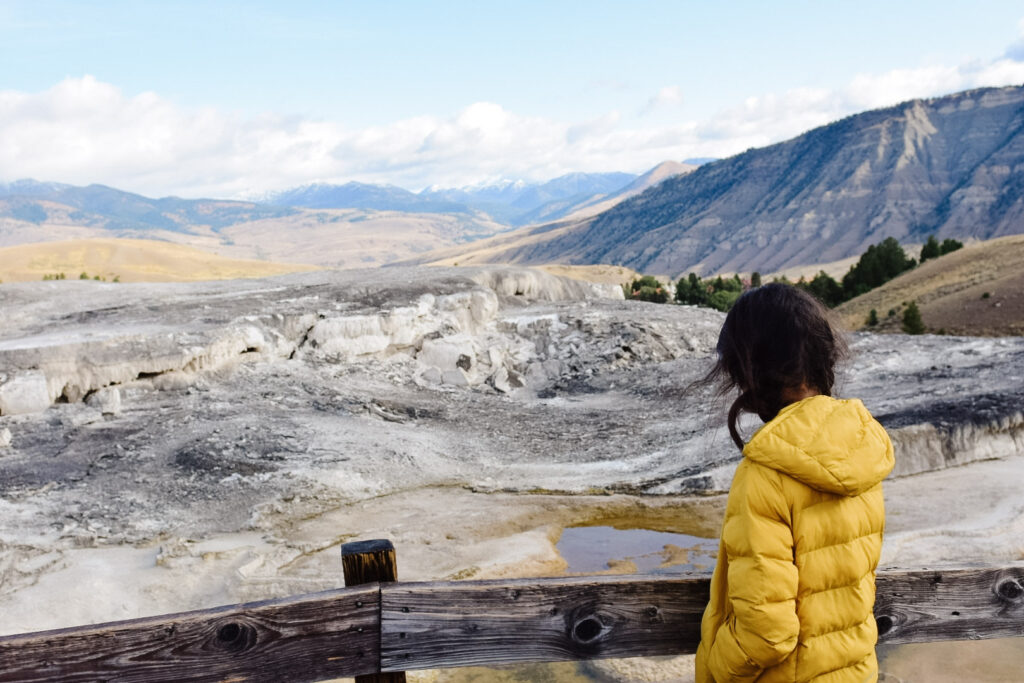
How To Get to Yellowstone National Park
The closest international airport to Yellowstone is in Bozeman, MT. Bozeman Yellowstone International Airport is about 1.5 hours from the North entrance. Billings Logan International Airport, also in Montana, is a 3 hours drive to the closest park entrance. You will need a car to travel between either airport and the park. If you are taking a longer road trip, you could also consider flying to Salt Lake City, UT, which is 5 hours from the park.
There are also some regional airports near Yellowstone National Park:
- Yellowstone Regional Airport (Cody, WY): about 1.25 hours drive to closest entrance.
- Idaho Falls Regional Airport (Idaho Falls, ID): about 2 hours drive to closest entrance.
- Jackson Airport (Jackson, WY): about 2.25 hours dive to closest entrance.
Yellowstone has five entrance stations, and several are closed to regular vehicles during winter. It takes many hours to drive between these entrances, so be sure to check the status of roads at the entrance you intend to use while planning your trip and before you arrive.
How Many Days Should I Spend at Yellowstone National Park?
Because it’s such a huge park, it’s really important to go in with a good Yellowstone itinerary with kids to guide your visit. Here is my Yellowstone Family Itinerary.
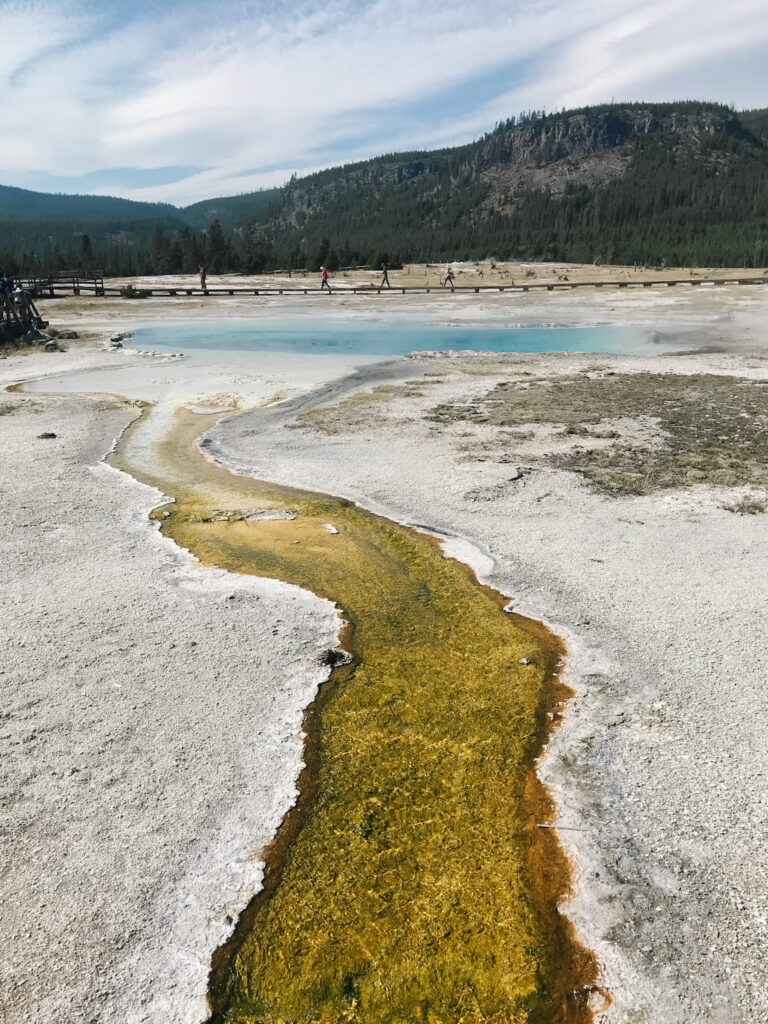
Where to Stay Near Yellowstone National Park: Yellowstone Lodging for Families
Camping in Yellowstone National Park
Yellowstone Lodging with Kids
Accommodations Inside the Park
Yellowstone National Park Lodges operates nine lodges (hotel- and cabin-style) in the park with more than 2,000 rooms. All are open from late spring through fall. Old Faithful Snow Lodge is open during winter. Be sure to make a reservation early!
- Canyon Lodge and Cabins: hotel-style lodge rooms and rustic cabins.
- Grant Village Lodge: hotel-style lodges.
- Lake Hotel and Cabins: large lodge and cabin accommodations.
- Lake Lodge Cabins: 186 cabins.
- Mammoth Hot Springs Hotel and Cabins: large lodge plus cabin accommodations.
- Old Faithful Inn: rustic lodge with hotel room-style accommodations.
- Old Faithful Lodge: cabin accommodations.
- Old Faithful Snow Lodge: large lodge and cabin accommodations.
- Roosevelt Lodge: cabin accommodations.
- West Yellowstone:
- Gardiner:
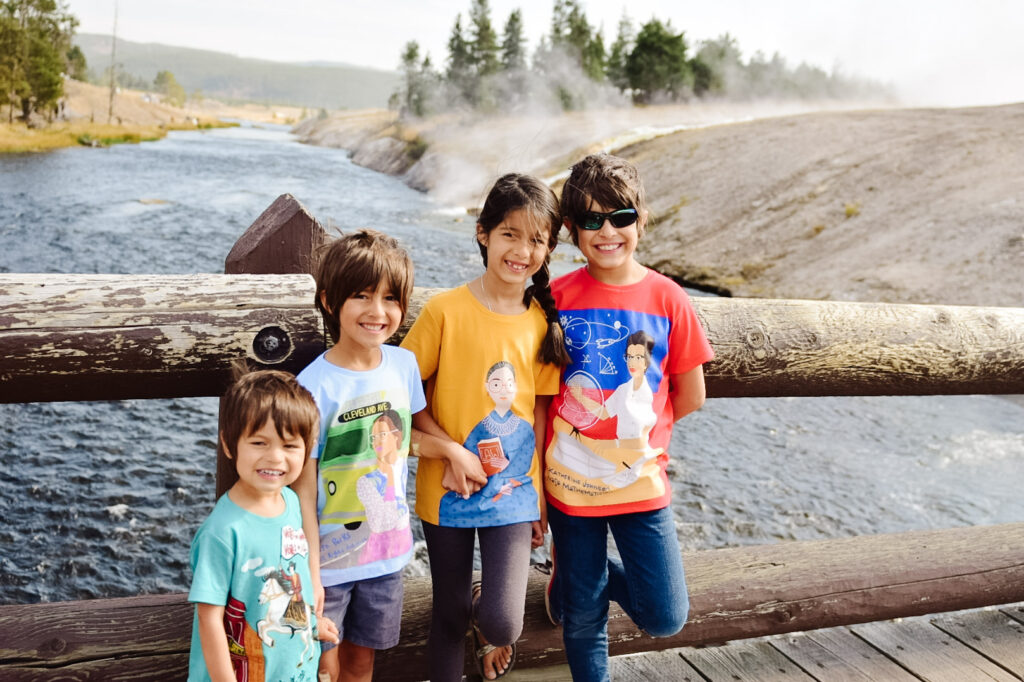
Where to Eat: Yellowstone National Park
Where to Eat in Yellowstone National Park
Be sure to check operating hours as many of these are closed or have reduced hours outside of high season.
Canyon Village
- Canyon Lodge: Eatery, Falls Cafe, Ice Creamery, M66 Grill
- Canyon General Store: 60s-style burger diner and ice cream counter
- Washburn Lodge: Washburn Lookout
Grant Village
- Grant Village Lodge: Dining Room
- Lake House at Grant
- Grant Village General Store: Grill and ice cream counter
Lake Village, Fishing Bridge, and Bridge Bay
- Lake Hotel and Cabins: Lake Hotel Dining Room, Lake Hotel Deli
- Lake Lodge and Cabins: Cafeteria
- Lake General Store: Concession and ice cream counter
- Fishing Bridge General Store: Grill and ice cream counter
Mammoth Hot Springs
- Mammoth Hot Springs Hotel and Cabins: Mammoth Hotel Dining Room, Terrace Grill
- Mammoth General Store: Concession and ice cream counter
Old Faithful
- Old Faithful Inn: Old Faithful Inn Dining Room, Bear Paw Deli, Bear Pit Lounge, coffee counter
- Old Faithful Snow Lodge: Obsidian Dining Room, Geyser Grill, and coffee counter
- Old Faithful Lodge: Cafeteria, Bake Shop / Lobby Snack Shops, and ice cream counter
- General Stores (Upper and Lower): Upper – Concession and ice cream counter; Lower – Grill and ice cream counter
Tower / Roosevelt
- Roosevelt Lodge: Roosevelt Lodge Dining Room and Old West Dinner cookout
- Tower Fall General Store: Concession and ice cream counter
Where to Eat near Yellowstone National Park
- West Yellowstone:
- Mountain Mama’s Coffee House & Bakery: casual to-go breakfast pastries and lunch sandwiches; take and bake dinner.
- Espresso West: coffee and ice cream shop.
- Firehole BBQ Company: barbeque lunch and dinner.
- Gardiner:
- Tumbleweed Cafe: casual and to-go breakfast, lunch and dinner.
- Wonderland Cafe: breakfast pastries to-go or seated American lunch and dinner.
- Yellowstone Pizza Company: pizza lunch and dinner.
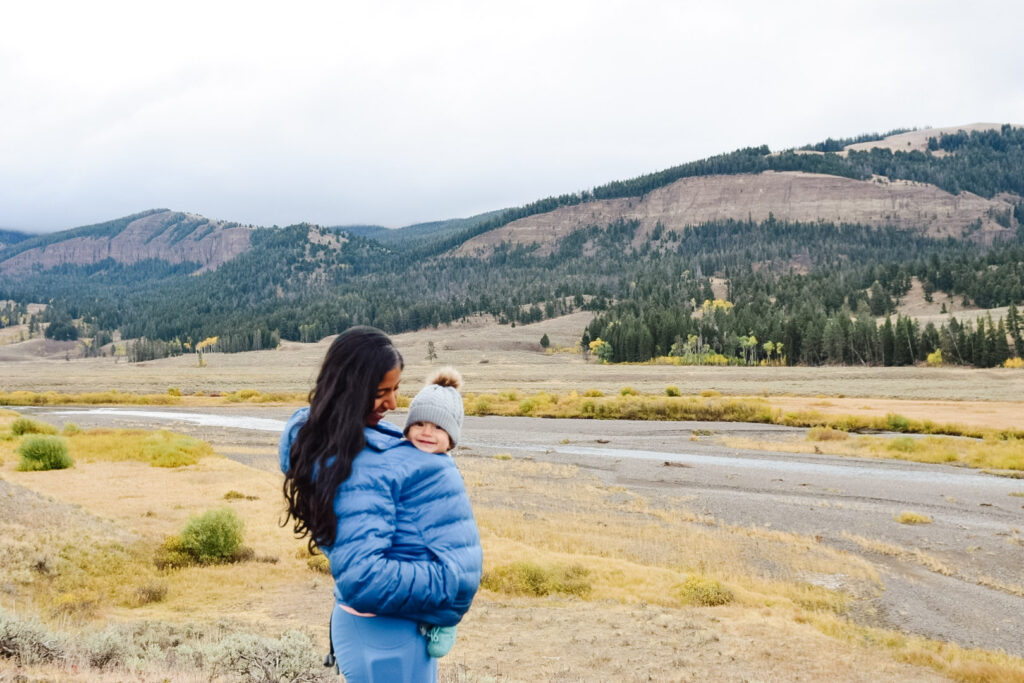
How to Get Around Yellowstone National Park: Yellowstone Transportation
You will need a vehicle to visit Yellowstone National Park. Around 50 miles of road separates popular destinations like Old Faithful and the Grand Canyon of the Yellowstone. Public transportation is not available in Yellowstone, but many companies provide shuttle services and tours.
And here is a complete post about traveling with car seats. Here are our favorites by age:
- Favorite Infant Car Seat For Travel Available at: Amazon, Target, Walmart
- Favorite Convertible Car Seat For Travel Available at: Walmart
- Favorite Booster Restrain Vest For Travel Available at: RideSafer
- Favorite Booster Seat For Travel Available at: Amazon
Best Time to Go to Yellowstone: Yellowstone National Park Weather
If you’re wondering when to visit Yellowstone National Park, I highly recommend visiting in late spring or early fall. The weather is still generally very pleasant during these times, and you miss the extreme heat and crowds of July and August.
Still, if you can only visit Yellowstone during the summer, there are plenty of opportunities to escape the crowds. You can do this by heading to some of the lesser-visited spots below.
Yellowstone National Park in winter is still stunning, but beware that many of the park roads are closed. I would highly recommend hiring a guide during this time to be able to travel safely regardless of weather. This will ensure you get the most out of your visit. Here are some great things to do in Yellowstone in winter, and a whole list of wonderful winter activities in Idaho!
In any time of year, a tour really can be an amazing way to see the park, especially if you’re interested in spotting wildlife. This wolf watching and wildlife safari is a perfect opportunity to go with experienced, terrific guides to safely observe some of the parks residents. This Upper Loop tour is a good option that runs all year, or this private wildlife tour. A self-guided audio tour can also be a great addition to your Yellowstone adventure!
MAP: Best Things To Do in Yellowstone With Kids
See THIS MAP to view all the best sites for a Yellowstone family vacation!

Top Yellowstone Checklist of the Best Things to Do in Yellowstone National Park
- Visit the iconic Old Faithful geyser & other parts of the Upper & Midway Geyser Basin
- See Grand Prismatic Hot Spring in Midway Geyser Basin
- Take in the “Grand Canyon of Yellowstone” at Artist Point
- Hike Mud Volcano
- Visit Fountain Paint Pot
- Explore the travertine terraces of Mammoth Hot Springs
- View wildlife in Lamar Valley
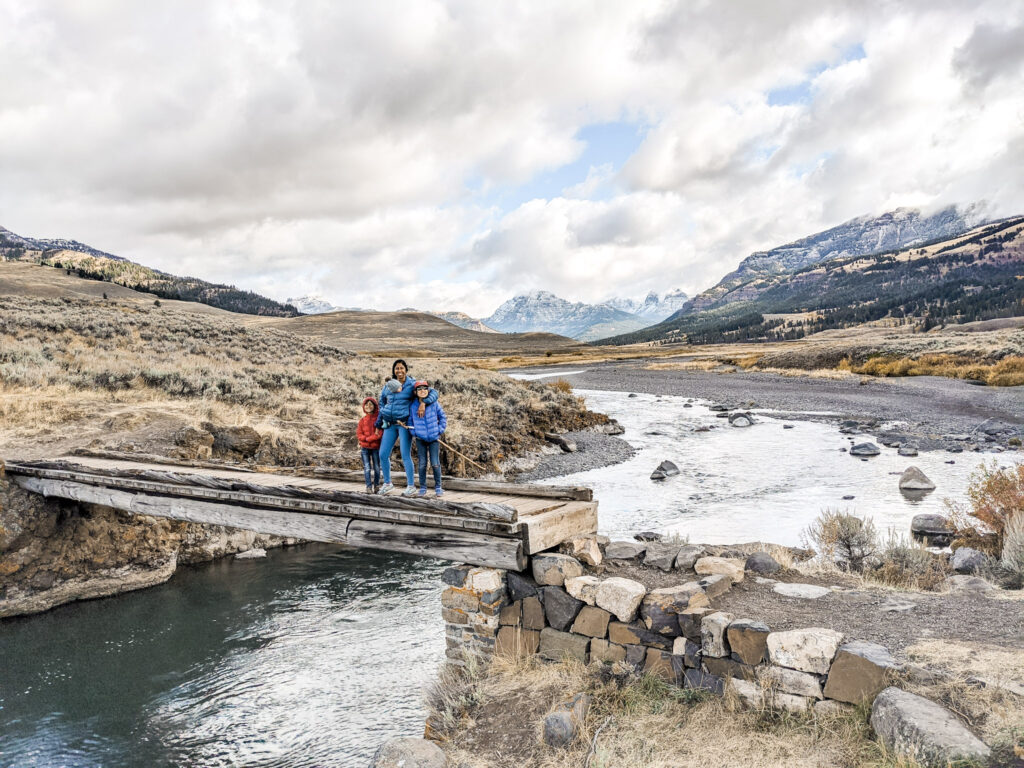
Best Things to Do in Yellowstone National Park: Yellowstone National Park Itinerary & Unique Things To Do in Yellowstone National Park
1. Check Out the Visitor Centers
Ten visitor centers and information stations are found throughout the park. It’s a huge park with a lot to see, so it’s well worth stopping in to talk with a ranger, discover more about the park’s resources through exhibits and interpretive offerings, or get oriented to the park. Check this page for more details about visitor center hours.
Though the education centers play the role of visitor centers, there are some unique things to see at each.
- Canyon Visitor Education Center: learn more about the geologic story of the area, including the Yellowstone volcano, and view a room-size relief map of Yellowstone. You can also get orientation information, pick up a fishing permit, shop for a souvenir, find out what ranger programs are available, and watch the park film.
- Old Faithful Visitor Education Center: offers views of the geyser’s eruption from the tall, windowed front of the visitor center. Additionally, you can gather park information, talk with a park ranger at the front desk, shop for souvenirs in the park store, delve into the natural wonders of Yellowstone in the exhibit hall, or join a ranger program.
2. Watch Old Faithful Erupt
Visiting at least one of Yellowstone National Park’s thermal basins is a must-do, as the park’s icon status largely comes from its famous hydrothermal features. And, of course, watching Old Faithful Geyser erupt is a Yellowstone National Park tradition. Watch eruptions from the Old Faithful viewing area or along the boardwalks that weave around the geyser and through the Upper Geyser Basin. When visiting Old Faithful, you can find when next eruption is predicted at the Old Faithful Visitor Education Center, at the lodges, and in the NPS App.
Note that while there is a walk all around the Old Faithful area, you can watch the eruption itself from a viewing area very close to the parking area.
3. Junior Ranger Program
Yellowstone National Park has a self-guided Junior Ranger program for children 4 years and older (although younger kids are allowed to participate, too). Activities help participants learn more about hydrothermal geology, wildlife, fire ecology, and much more. Get your full-color booklet at any Yellowstone National Park visitor center, or download a copy of the Junior Ranger booklet before you arrive. (Note that unlike in most National Parks, there is a small fee for the booklet in the visitor center due to the visitation numbers.)
After completing the age-appropriate requirements described inside the booklet and having your book reviewed by a park ranger at a visitor center, you will be awarded an official Yellowstone Junior Ranger badge!
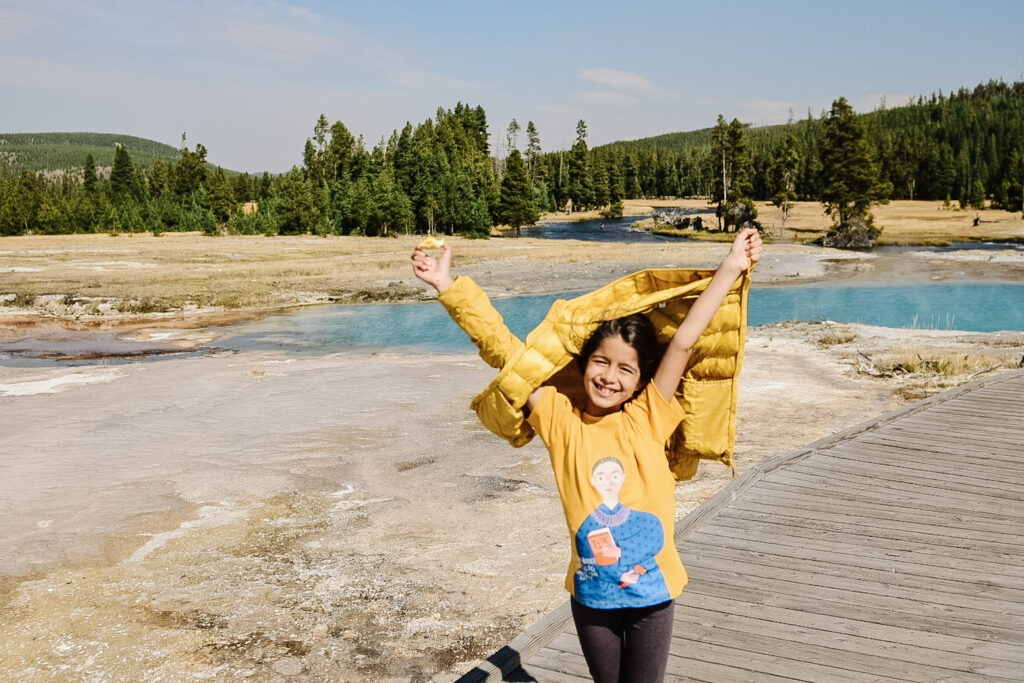
4. Hiking at Yellowstone National Park: Best Hikes for Families at Yellowstone National Park
Here are a few family-friendly hikes in Yellowstone National Park:
- Grand Prismatic Spring (must-do!) – 1.2 mi. out and back; 200 ft. elevation gain
- Upper Geyser Basin & Old Faithful Observation Loop – 4.9 mi. loop; 357 ft. elevation gain
- If you want a slightly shorter loop, try the Upper Geyser Basin Loop for 3.5 mi.
- Fairy Falls – 4.8 mi. out and back; 170 ft. elevation gain
- Mystic Falls, Fairy Creek & Little Firehouse Loop – 3.5 mi. loop; 606 ft. elevation gain
- Mammoth Terraces – 2.5 mi. loop; 383 ft. elevation gain
- Midway Geyser Basin – 0.7 mi. loop; 55 ft. elevation gain
- Canyon Rim South to Artist Point – 2.5 mi. out and back; 278 ft. elevation gain
- West Thumb Geyser Basin – 1.0 mi. loop; 62 ft. elevation gain (home to Yellowstone’s deepest hydrothermal pool, Abyss Pool)
- Brink of the Lower Falls – 0.7 mi. out and back; 265 ft. elevation gain
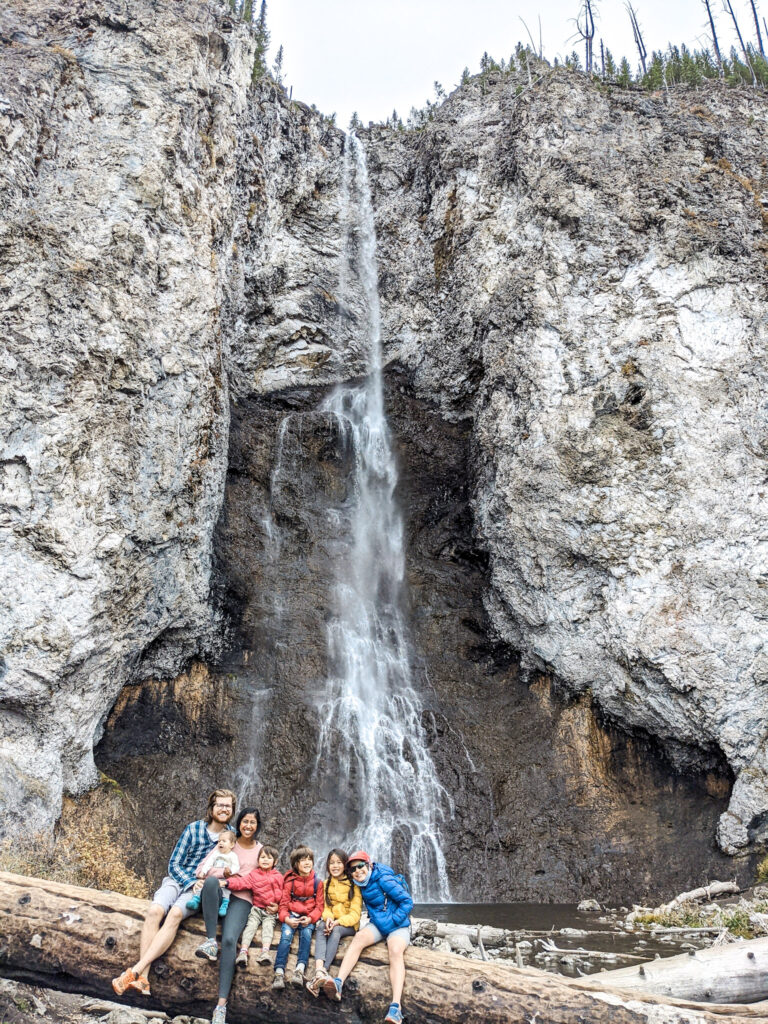
5. See the Wildlife at Yellowstone National Park
Yellowstone’s abundant wildlife is as famous as its geysers. In the park, animals have over 3,000 square miles (over 7,500 square km) of habitat available to them, so seeing them usually involves both luck and timing. Check at visitor centers for information about recent sightings, or join one of several companies that provide wildlife watching tours in the park.
When to go: Animals tend to feed during early morning and evening and may be more visible at these times because they’re up and moving around. Bears begin emerging from hibernation in March and April and can often be seen grazing in roadside meadows until the heat of summer pushes them to higher elevations. Winter is a great time to watch wolves because they’re out of their dens (pups usually emerge in May) and easier to see on a snowy landscape.
Where to go: Below are a few popular destinations for watching some of the park’s large mammals, and what might be seen during certain times of the year. If I were to pick only one area to definitely go to try to see an abundance of wildlife, I’d head to Lamar Valley at sunrise. Though it’s further out than Hayden Valley, the abundance of wildlife – especially since far fewer visitors make it out that way – is astonishing.
- Fishing Bridge: Grizzly bears
- Hayden Valley: Bison, black bears, elk, grizzly bears, wolves
- Lamar Valley: Bison, black bears, bighorn sheep, elk, grizzly bears, mule deer, pronghorn, wolves
- Mammoth Hot Springs: Bison, black bears, elk, mule deer
- Madison: Bison, elk
- North Entrance: Bighorn sheep, bison, elk, pronghorn
- Northeast Entrance: Moose
- Old Faithful: Bison, elk
- South Entrance: Moose
- West Thumb: Elk, moose
6. Birding in Yellowstone
Records of bird sightings have been kept in Yellowstone since its establishment in 1872. These records document nearly 300 species of birds to date, including raptors, songbirds, shorebirds, and waterfowl. Approximately 150 species nest in the park. Many birds, such as American robins and common ravens, are found throughout the park. Other species live in specific habitats. Hayden Valley is one of the best places to view water birds and birds of prey.
Spring is a good time to look for birds. Migration brings many birds back to the park from their winter journeys south; other birds are passing through to more northern nesting areas. Songbirds are singing to establish and defend their territories; and many ducks are in their colorful breeding plumages, which makes identification easier.
Watch for birds on early morning walks from mid-May through early July. Most birds migrate to lower elevations and more southern latitudes beginning in August. At the same time, other birds pass through Yellowstone. Hawk-watching can be especially rewarding in Hayden Valley late August through early October. In early November, look for tundra swans on the water.
See this page for the Yellowstone Birding Checklist.
7. Visit Hot Springs, Including Grand Prismatic
Yellowstone is justifiably famous for its brilliantly colored hot springs, and it’s well worth taking the time to visit at least a couple. Grand Prismatic Hot Spring is, of course, the most famous, and the overlook trail (just over a mile round trip) provides an excellent view. Other parts of Midway Geyser Basin, where Grand Prismatic is located, are also gorgeous, as is Biscuit Basin. If you’re willing to drive just a bit further, head 30 minutes away to West Thumb Geyser Basin, which is also beautiful and often less crowded.
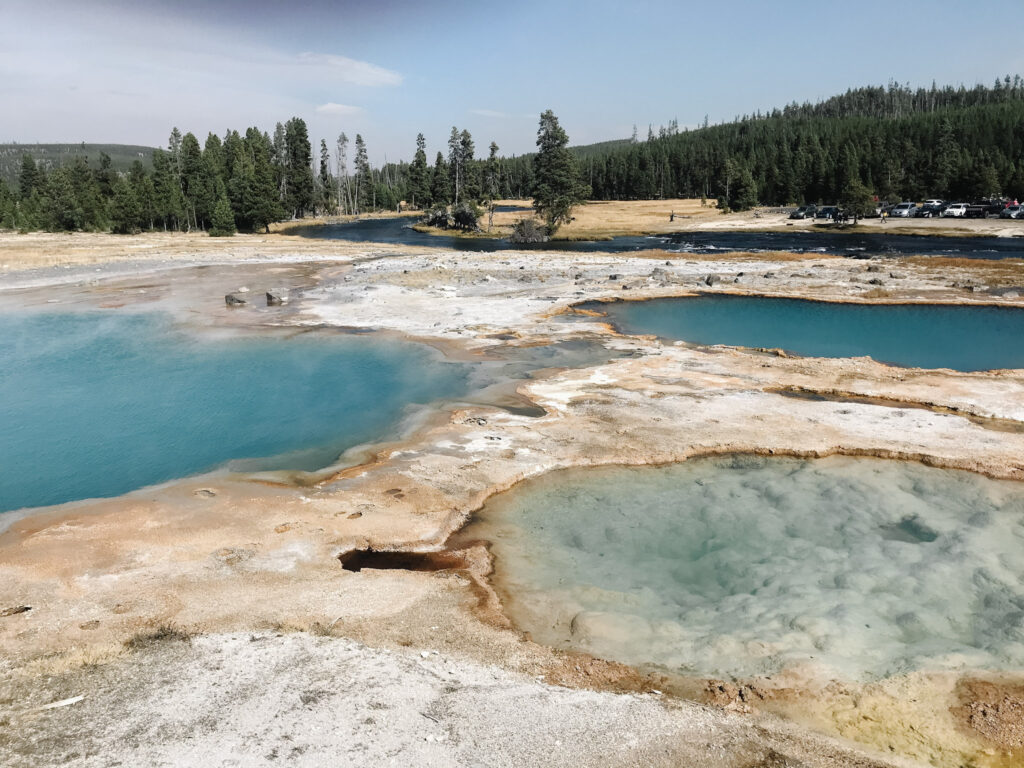
8. Listen to Mud Gurgle at Mud Volcano or Fountain Paint Pots
The hydrothermal features at Mud Volcano are primarily mudpots and fumaroles because the area is situated on a perched water system with little water available. This is a very active area, with features like the aptly named Churning Cauldron and Black Dragon’s Cauldron. The loop is just over half a mile, but you may find yourself spending some extra time looking at the mud pots, hot springs, and other incredible features.
The Fountain Paint Pots are another excellent option as all 4 major geothermal features in the park are represented there: geysers, hot springs, mud pots, and fumaroles.
9. Biking in Yellowstone National Park
Biking is an incredible way to experience Yellowstone! Mountain bikes, road bikes, and e-bikes are permitted on established public roads, parking areas, and designated routes in Yellowstone National Park in the summer. In the spring and fall, they are permitted on roads closed to regular vehicles while weather conditions allow.
Rent a bike at Old Faithful Snow Lodge in the heart of Yellowstone’s geyser country.
These businesses provide guided bicycle trips in Yellowstone.
Designated Biking Trails
- Abandoned Railroad Bed
- Bunsen Peak Loop
- Fountain Freight Road
- Lone Star Geyser
- Mount Washburn
- Natural Bridge
- Old Lake
- Riverside
Spring Biking Roads
- Mammoth Hot Springs to the West Entrance (49 miles)
- East Entrance to east side of Sylvan Pass (6 miles)
Fall Biking Roads
- Madison Junction to Old Faithful (16 miles)
- Tower-Roosevelt to Chittenden Road (6 miles)
- South Entrance to West Thumb (22 miles)
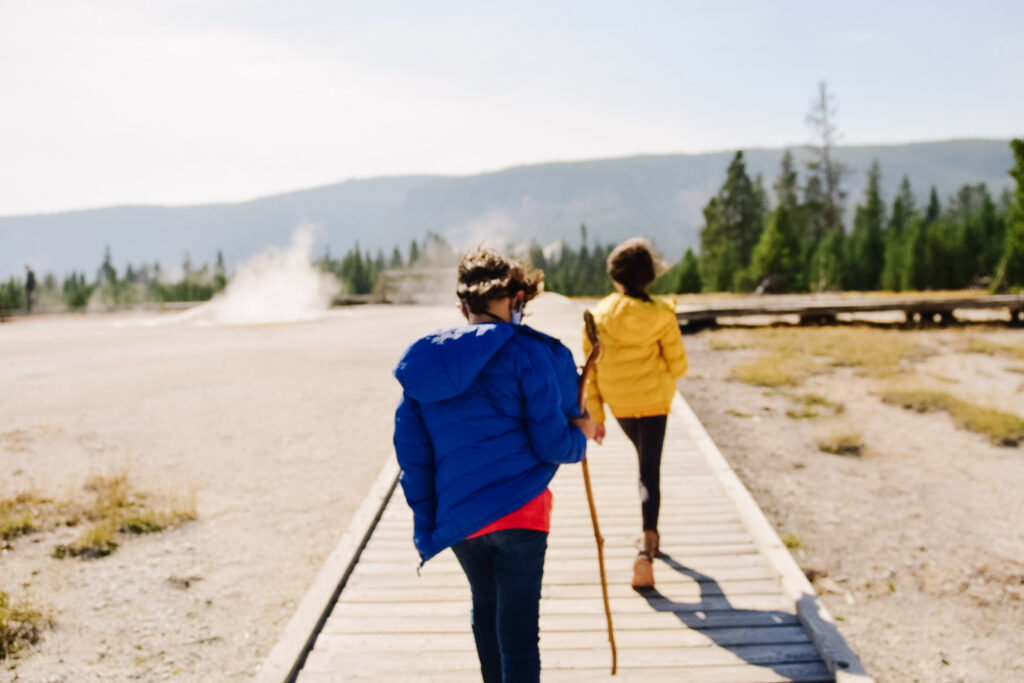
10. Visit the Museum of the National Park Ranger
Once a US Army outpost built in 1908, the Museum of the National Park Ranger houses exhibits that celebrate the history of the park ranger profession. To enhance the story of the park ranger experience, this visitor center is staffed by volunteer retired rangers. There’s also a selection of videos that pertain to the Norris Soldier Station, Norris Geyser Basin, and other park topics.
11. Join a Ranger Program
One of the best ways to experience a national park is participating in a ranger program. Yellowstone National Park offers a variety of ranger programs throughout the park and throughout the year. Check the calendar, the newspaper, or the NPS App for daily activities and at visitor centers for local announcements for special pop-up programs being offered in your area.
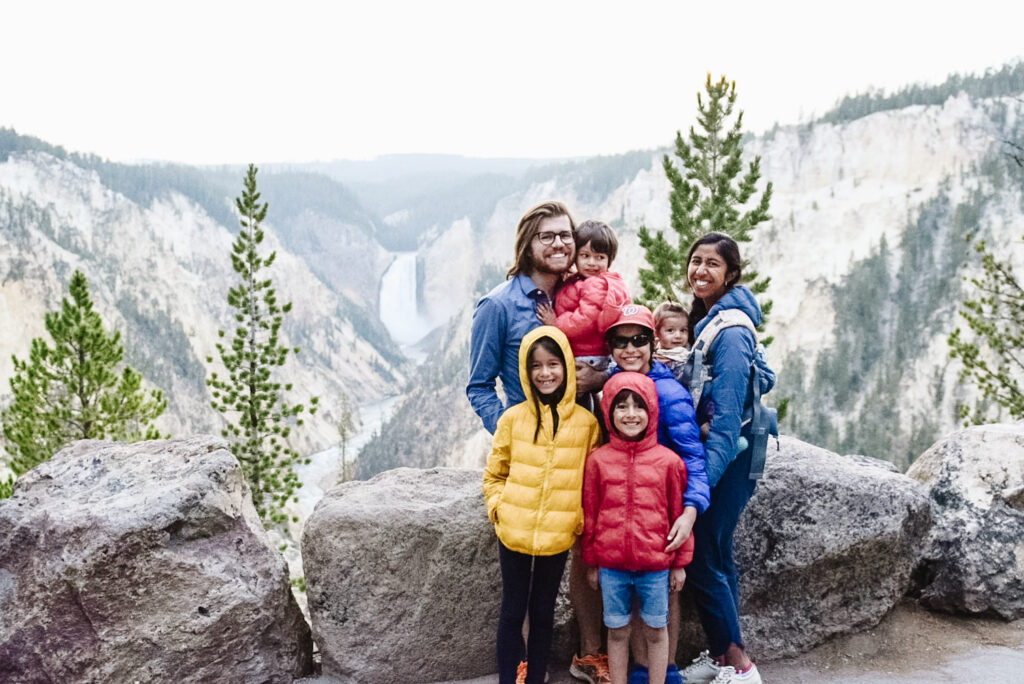
12. Visit the Grand Canyon… of Yellowstone
Did you know there’s a Grand Canyon is Yellowstone?!? The Grand Canyon of the Yellowstone is roughly 20 miles long, measured from the Upper Falls to the Tower Fall area. The canyon was formed by erosion as Yellowstone River flowed over progressively softer, less resistant rock.
Experience the canyon from a variety of overlooks, at different times of day, and at different seasons. A number of trails and walkways wind along the rims and down partway into the canyon.
Check out the hike details and accessibility information.
13. Walk Amongst the Travertine Terraces at Mammoth Hot Springs
The Mammoth Hot Springs area in the northern region of the park is fascinating and so unique. It’s magical and otherworldly walking on boardwalks amongst the travertine terraces, and seeing them lit up early or late in the day is a special treat. Keep in mind that this area does not have shade and can get very hot in the summer, so consider going when temperatures are cooler.
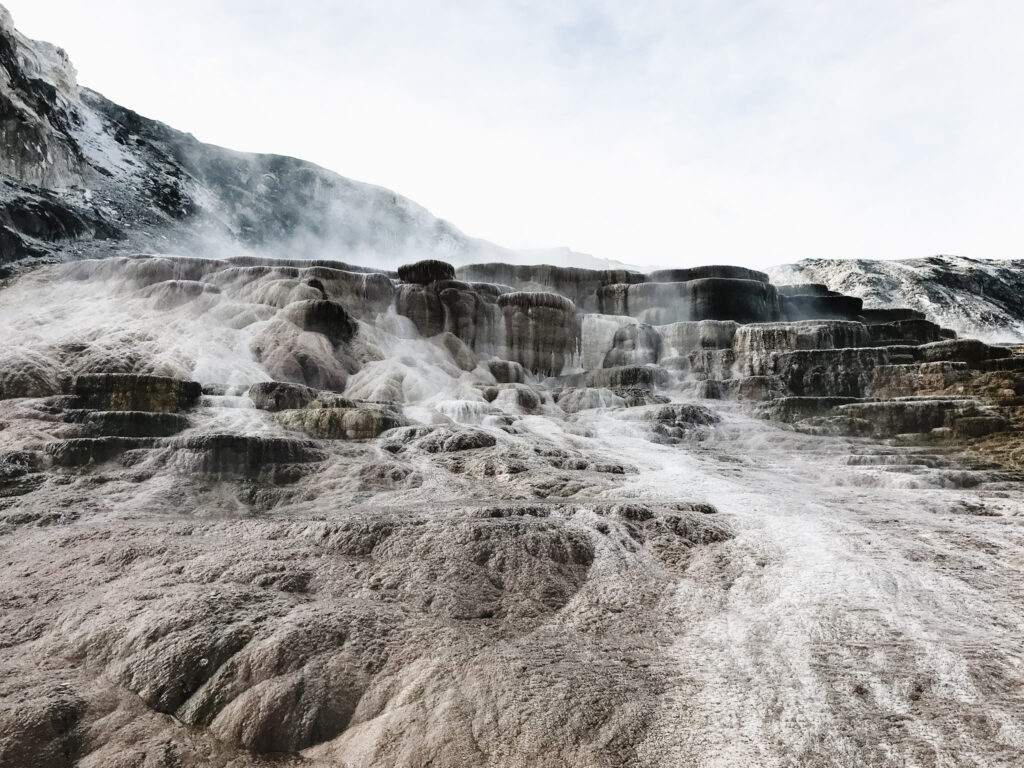
14. Take a Scenic Drive
Enjoy a beautiful drive through Firehole Canyon. Firehole Canyon Drive follows the Firehole River upstream from Madison Junction to just above Cascades of the Firehole. The drive takes you past 800-foot thick lava flows and to a viewing area of Firehole Falls, a 40-foot (12.2-m) waterfall.
Also along the drive is an unstaffed swimming area, which is very popular in the warmest part of the summer season. Learn more about swimming and soaking in Yellowstone.
You can also drive Yellowstone’s 140-mile Grand Loop, comprised of the Upper and Lower Loop. This is a grand tour of Yellowstone that will bring you to most of the main attractions (excluding Lamar Valley). Each loop takes at least 2.5-3 hours to drive with NO stops, and I definitely plan on stopping to see many fascinating things along the way, so plan on at least a couple days to explore. More on the park’s roads HERE.
15. Go Cross Country Skiing or Snowshoeing in Yellowstone National Park
Yellowstone has miles of trails for the adventurous skier and snowshoer. Though track is set only on a few trails, all unplowed roads and trails are open to cross-country skiing and snowshoeing. Whether you are skiing a groomed trail in a developed area or venturing into the backcountry, remember that you are traveling in wilderness with all its dangers: unpredictable wildlife, changing weather conditions, hydrothermal areas, deep snow, open streams, and avalanches. Talk with park rangers before you leave on any trip and get specific information on conditions.
Find ski and snowshoe trail here.
16. Boating in Yellowstone National Park
Yellowstone National Park Lodges provides boat rentals and guided boat trips at Bridge Bay Marina on Yellowstone Lake. Other companies offer guided services for canoeing, kayaking, and motorized boating. You can also find guides for fishing, photography, rafting, and wildlife viewing tours here.
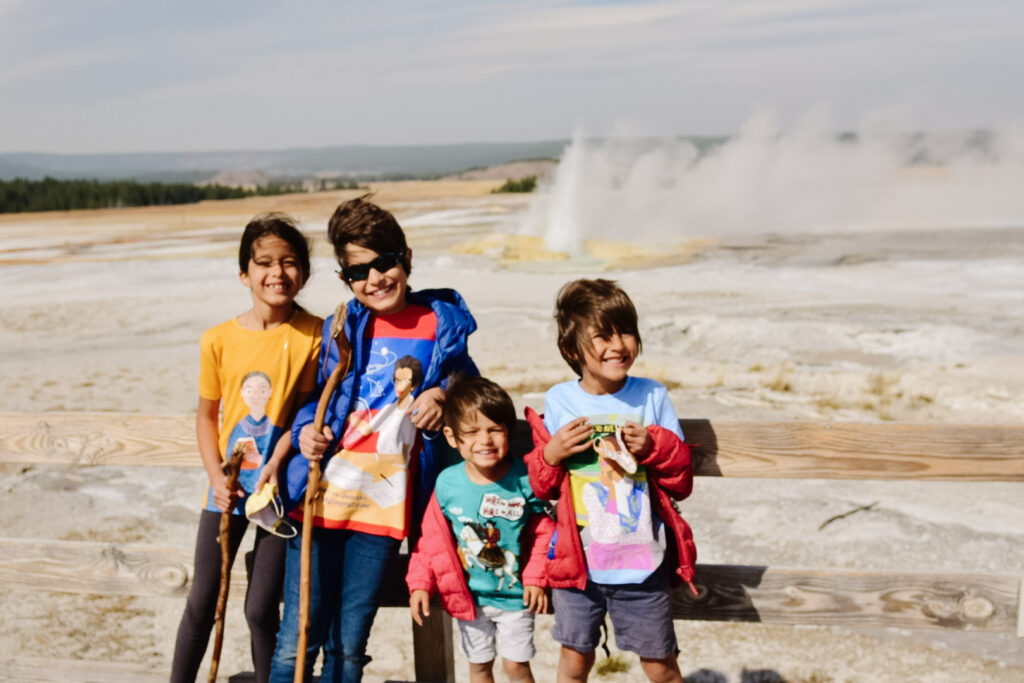
17. Take a Tour of the Fort Yellowstone Historic District
This area features buidlings constructed during Yellowstone’s Army era and is still used as park headquarters as well as employee housing. Guided tours are available of the area. Learn more about the area HERE.
18. Visit the Lamar Buffalo Ranch
The Lamar Buffalo Ranch was built in the early part of the 20th century in an effort to increase the herd size of the few remaining bison in Yellowstone, preventing the feared extinction of the species. Buffalo ranching operations continued at Lamar until the 1950s. Remnants of irrigation ditches, fencing, and water troughs can still be found. Four remaining buildings from the original ranch compound are contained within the Lamar Buffalo Ranch Historic District and are on the National Register of Historic Places. (Note: this site is drive-by only and has no public facilities.)
19. Photography in Yellowstone National Park
People travel from around the world to take pictures in Yellowstone. Where else can you witness the birth of a bison calf, see a grizzly bear steal a kill from a wolf, or watch the sun set behind an erupting geyser?
Here are popular spots to take amazing photos:
- Grand Prismatic Spring
- Lower Falls of the Yellowstone River
- Old Faithful and other geysers in Upper Geyser Basin
- Animals in Lamar Valley
- Sunrise at Yellowstone Lake
- Sunset at Lower Geyser Basin
- Wildflowers at Dunraven Pass
Photo Equipment
- Camera
- 70-200mm lens (for wildlife)
- 24-70mm lens
- 15-35mm lens (for astrophotography)
- Tripod
- ND Filter
- Remote
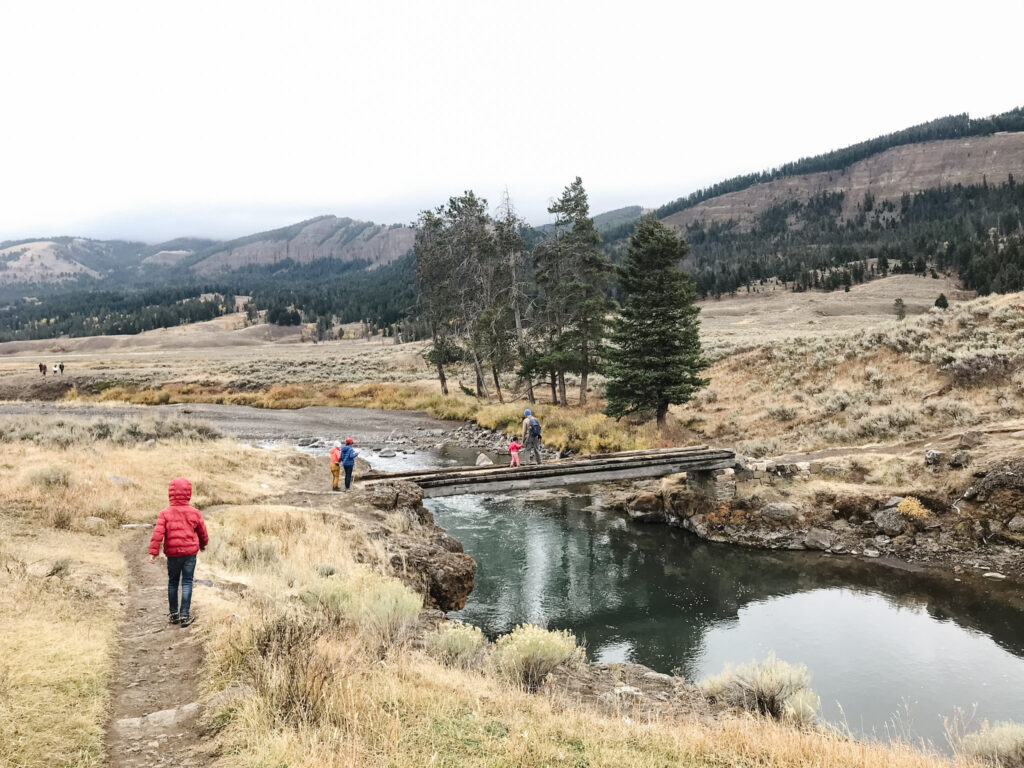
Enjoy Your Visit to Yellowstone National Park with Kids!
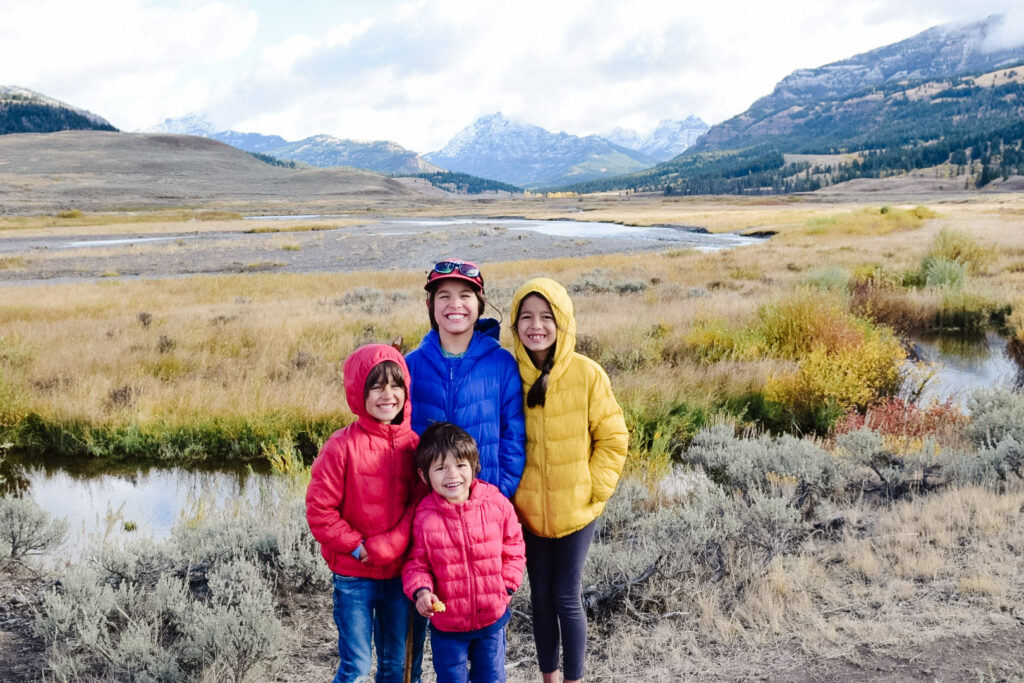
MORE POSTS
IF YOU LIKED THIS POST ABOUT THE BEST THINGS TO DO IN YELLOWSTONE NATIONAL PARK, YOU MIGHT LIKE THESE POSTS TOO:
- What to Pack for Alaska With Kids: Alaska Summer Packing List
- Our 4 Months of Full Time RVing Itinerary
- Grand Teton Itinerary with Kids
- Best US National Parks by Month






